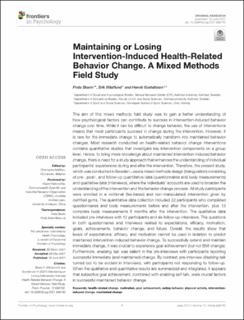| dc.description.abstract | The aim of this mixed methods field study was to gain a better understanding of how psychological factors can contribute to success in intervention-induced behavior change over time. While it can be difficult to change behavior, the use of interventions means that most participants succeed in change during the intervention. However, it is rare for the immediate change to automatically transform into maintained behavior changes. Most research conducted on health-related behavior change interventions contains quantitative studies that investigate key intervention components on a group level. Hence, to bring more knowledge about maintained intervention-induced behavior change, there is need for a study approach that enhances the understanding of individual participants' experiences during and after the intervention. Therefore, the present study, which was conducted in Sweden, used a mixed methods design (triangulation) consisting of pre-, post-, and follow-up quantitative data (questionnaires and body measurements) and qualitative data (interviews), where the individuals' accounts are used to broaden the understanding of the intervention and the behavior change process. All study participants were enrolled in a volitional (fee-based and non-manipulated) intervention given by certified gyms. The quantitative data collection included 22 participants who completed questionnaires and body measurements before and after the intervention, plus 13 complete body measurements 6 months after the intervention. The qualitative data included pre-interviews with 12 participants and six follow-up-interviews. The questions in both questionnaires and interviews related to expectations, efficacy, motivation, goals, achievements, behavior change, and future. Overall, the results show that levels of expectations, efficacy, and motivation cannot be used in isolation to predict maintained intervention-induced behavior change. To successfully extend and maintain immediate change, it was crucial to experience goal achievement (but not BMI change). Furthermore, enabling talk was salient in the pre-interviews with participants reporting successful immediate (and maintained) change. By contrast, pre-interview disabling talk turned out to be evident in interviews, with participants not responding to follow-up. When the qualitative and quantitative results are summarized and integrated, it appears that subjective goal achievement, combined with enabling self-talk, were crucial factors in successful maintained behavior change. | en_US |
